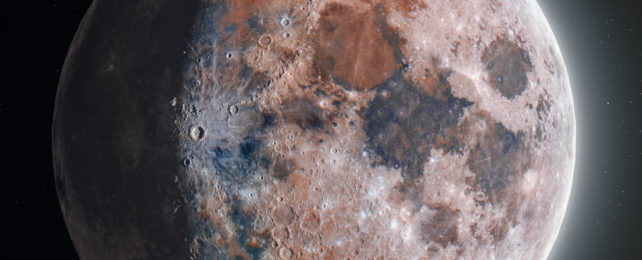The Moon is known for its numerous craters that preserve the scars of turbulence from above. But just beneath the shattered lunar surface lies evidence of a succession of lava flows, detailing a different kind of chaos in the Moon's past arising from below.
Jianqing Feng, an astrophysicist at the Planetary Science Institute in Arizona, and his colleagues in China and the UK wanted to expand on previous studies of the lunar subsurface that fell, well, a little flat.
Like those previous studies, Feng and his colleagues analyzed data from the Chang'e-4 rover, which landed on the far side of the Moon in 2019. Only this time they had much more data to work with beyond Chang'e-4's first few lunar days, and peered deeper into the lunar surface using lower frequencies of ground-penetrating radar.
Lunar penetrating radar is an instrument aboard Chang'e-4. It emits pulsing signals into the lunar subsurface as the rover moseys along. If these radar signals strike a clear contrast between two subsurface materials with different properties, they get reflected back up to the surface where the receiver awaits.
Aside from an old crater hidden by debris and soil flung from nearby impacts, Feng and colleagues found nothing too unusual in the top 40 meters (131 feet) of the Moon.
Below 90 meters (295 feet) things got a little more interesting.
"Through this investigation, we have discovered multiple layers in the upper 300 meters, which likely indicate a series of basalt eruptions that occurred billions of years ago," Feng and colleagues write in their paper.
Lunar volcanism has been a hot topic lately. Last month, scientists found a strange hotspot on the far side of our satellite, which could be a buried mass of solidified magma produced by a type of volcanism not seen on the Moon before.
Thanks to the first lunar rocks retrieved in more than four decades, we've also come to learn lava flowed from volcanoes on the Moon a billion years longer than previously thought.
The layers of hardened lava detected by Feng and his colleagues are another record of that long history. Thicker layers were found deeper down, though they thinned towards the surface, suggesting a "gradual depletion of internal thermal energy that drove [lunar] volcanism" and "a decrease in eruption scale over time."
The thickest layers were about 70 meters (or 230 feet) wide, and the lava flows thinned to around 5 meters wide at shallower depths near the landing site.
All up, Feng and colleagues think they have identified at least three or four large lava flow events, some of which appear quite close together, sandwiching a thin sprinkling of lunar soil between the hardened rock.
After cross-checking their measurements against data from the previous lunar module, Chang'e 3, the researchers say these layers are representative of subsurface features across the Von Kármán crater where Chang'e 4 has been roving, as rovers do.
However, remote-sensing data can't tell us anything about the timing of lunar volcanic events, only that they appear to get smaller over time until the Moon's thermal energy petered out. Other recent studies have attempted to iron out kinks in our understanding of the Moon's last surges of volcanic activity.
Space scientists have also been debating how to interpret low-frequency lunar penetrating radar data. Some say the subsurface layers detected in previous studies are just system noise. So expect to see these new results scrutinized too.
The study has been published in the Journal of Geophysical Research: Planets.
